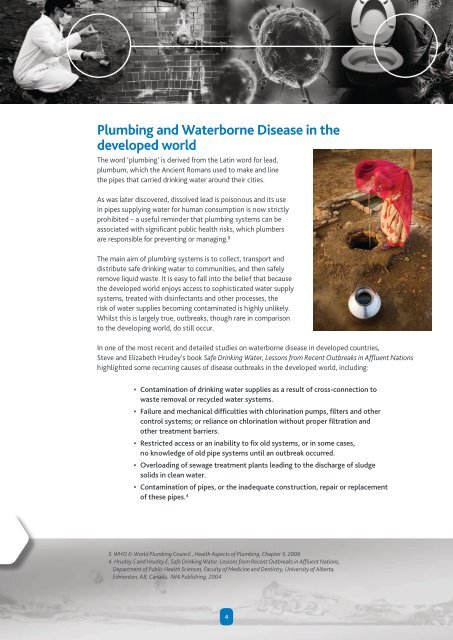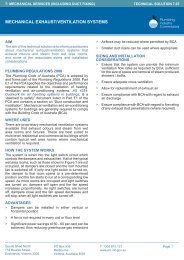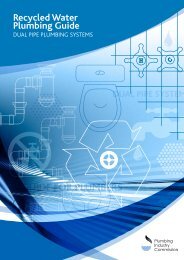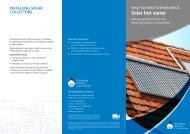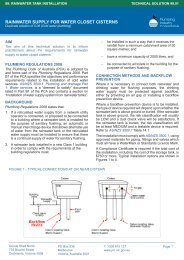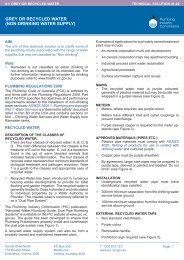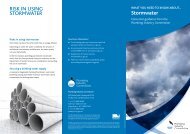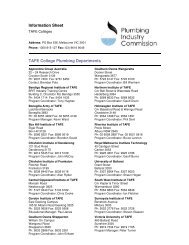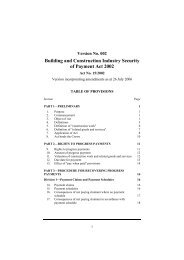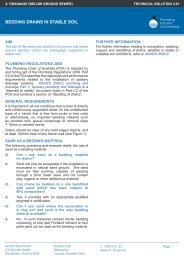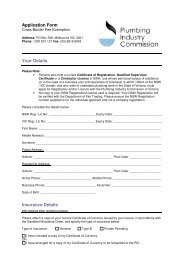current and emerging public health hazards - Plumbing Industry ...
current and emerging public health hazards - Plumbing Industry ...
current and emerging public health hazards - Plumbing Industry ...
You also want an ePaper? Increase the reach of your titles
YUMPU automatically turns print PDFs into web optimized ePapers that Google loves.
<strong>Plumbing</strong> <strong>and</strong> Waterborne Disease in thedeveloped worldThe word ‘plumbing’ is derived from the Latin word for lead,plumbum, which the Ancient Romans used to make <strong>and</strong> linethe pipes that carried drinking water around their cities.As was later discovered, dissolved lead is poisonous <strong>and</strong> its usein pipes supplying water for human consumption is now strictlyprohibited – a useful reminder that plumbing systems can beassociated with significant <strong>public</strong> <strong>health</strong> risks, which plumbersare responsible for preventing or managing. 3The main aim of plumbing systems is to collect, transport <strong>and</strong>distribute safe drinking water to communities, <strong>and</strong> then safelyremove liquid waste. It is easy to fall into the belief that becausethe developed world enjoys access to sophisticated water supplysystems, treated with disinfectants <strong>and</strong> other processes, therisk of water supplies becoming contaminated is highly unlikely.Whilst this is largely true, outbreaks, though rare in comparisonto the developing world, do still occur.In one of the most recent <strong>and</strong> detailed studies on waterborne disease in developed countries,Steve <strong>and</strong> Elizabeth Hrudey’s book Safe Drinking Water, Lessons from Recent Outbreaks in Affluent Nationshighlighted some recurring causes of disease outbreaks in the developed world, including:• Contamination of drinking water supplies as a result of cross-connection towaste removal or recycled water systems.• Failure <strong>and</strong> mechanical difficulties with chlorination pumps, filters <strong>and</strong> othercontrol systems; or reliance on chlorination without proper filtration <strong>and</strong>other treatment barriers.• Restricted access or an inability to fix old systems, or in some cases,no knowledge of old pipe systems until an outbreak occurred.• Overloading of sewage treatment plants leading to the discharge of sludgesolids in clean water.• Contamination of pipes, or the inadequate construction, repair or replacementof these pipes. 43. WHO & World <strong>Plumbing</strong> Council , Health Aspects of <strong>Plumbing</strong>, Chapter 3, 20064. Hrudey S <strong>and</strong> Hrudey E, Safe Drinking Water, Lessons from Recent Outbreaks in Affluent Nations,Department of Public Health Sciences, Faculty of Medicine <strong>and</strong> Dentistry, University of Alberta,Edmonton, AB, Canada, IWA Publishing, 20044


